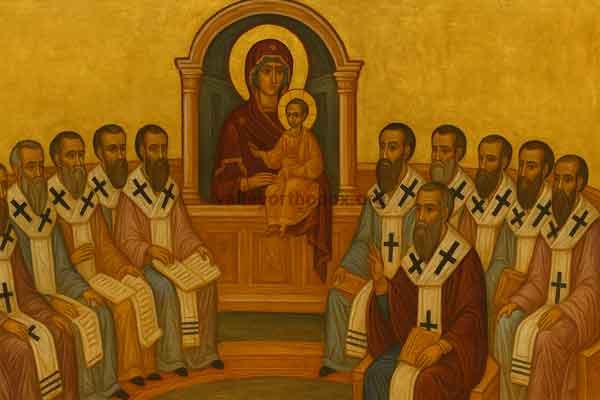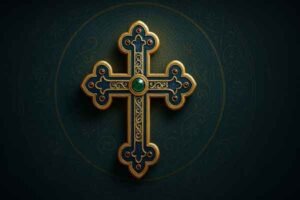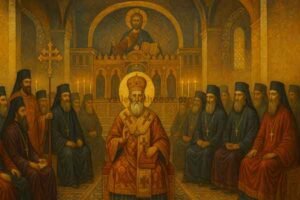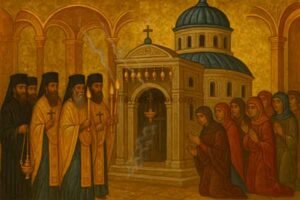The Third Ecumenical Council, convened at Ephesus in 431, affirmed the Virgin Mary as Theotokos (God-bearer) and safeguarded the unity of Christ’s person against teachings associated with Nestorius. Building on Nicaea (325) and Constantinople (381), the bishops clarified how the Church speaks of the Incarnate Word for worship, preaching, and catechesis.
Why Ephesus? Setting and Purpose
After Constantinople (381), debate intensified over how to speak of Christ’s divinity and humanity. Preaching in Constantinople sparked controversy when Nestorius resisted calling Mary “Theotokos,” preferring “Christotokos.” The heart of the issue: Is the one born of Mary truly God the Word incarnate, or only a man closely united to the Word?
Emperor Theodosius II summoned bishops to Ephesus—a city with deep Marian devotion—to restore doctrinal and ecclesial unity.
Central Teaching: Theotokos & One Person of the Word Incarnate
The council affirmed that the Virgin Mary is rightly called Theotokos, because the one she bore is the eternal Word become flesh. Christ is one and the same Person (hypostasis), the Son of God, who assumed complete humanity without ceasing to be God.
Cyril’s Letters
The bishops received Cyril of Alexandria’s Second Letter to Nestorius and his Letter to John of Antioch as orthodox expressions of the apostolic faith. Cyril’s famous “Twelve Anathemas”—while not all reproduced verbatim in the conciliar acts—summarize the concern: to confess one Christ who is truly God and truly man, not a moral partnership of two sons.
No “New Creed”
Ephesus prohibited composing a “new faith” beyond the Nicene symbol. The council defended the sufficiency of the Nicene Creed for confessing the Trinity and the Incarnation, ensuring stability for worship and catechesis.
Key Figures and Proceedings
- Cyril of Alexandria presided (holding the emperor’s commission) and opened the council when many bishops had arrived.
- Nestorius, summoned repeatedly, refused to appear and was deposed by the conciliar majority.
- John of Antioch arrived later with a group of bishops; subsequent negotiations led to the Formula of Reunion (433), which acknowledged the unity of Christ’s person and honored both Theotokos and the integrity of Christ’s two natures.
Pastoral takeaway: Ephesus prioritized language that protects the reality of the Incarnation for the sake of worship and salvation.
Canons and Practical Outcomes
Ephesus issued canons addressing jurisdiction, reconciliation, and the reception of those returning to the Church. The most consequential practical outcome was the deposition of Nestorius and the council’s insistence on no alterations to the Nicene Creed—a hedge against doctrinal instability.
Reception, Aftermath, and the Road to Chalcedon
Ephesus was received across the Orthodox world as a faithful articulation of the Nicene tradition. At the same time, tensions between Alexandrian and Antiochene theologians continued, prompting the Formula of Reunion (433) to express balance: one Christ, born of the Theotokos, perfect in divinity and humanity.
Controversies that followed—particularly around the language of nature(s)—led to Chalcedon (451), which defined Christ as one Person in two natures, “without confusion, change, division, or separation.”
Why Ephesus Matters for Orthodox Life
- Liturgy & Hymnography: Titles like Theotokos permeate the Divine Liturgy, festal hymns, and icons, shaping prayer.
- Catechesis: Ephesus supplies language for teaching how one and the same Jesus is both God and man.
- Unity of Worship: By forbidding new creeds, the council stabilized the confession used in baptism and Eucharist.
FAQs
What does “Theotokos” mean and why is it essential?
“Theotokos” means God-bearer. It safeguards the truth that the one born of Mary is God the Word incarnate—not a mere man later joined to the Word.
Did Ephesus define “two natures” in Christ?
Ephesus emphasized the unity of Christ’s person and affirmed Theotokos. The explicit language “one Person in two natures” was articulated later at Chalcedon (451).
Was Nestorius personally condemned as a heresiarch?
The council deposed Nestorius from his see; Orthodox reception treats the teaching associated with him as defective because it fractures the unity of Christ’s person.



